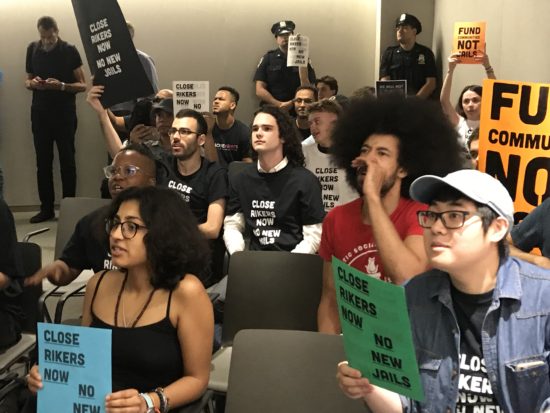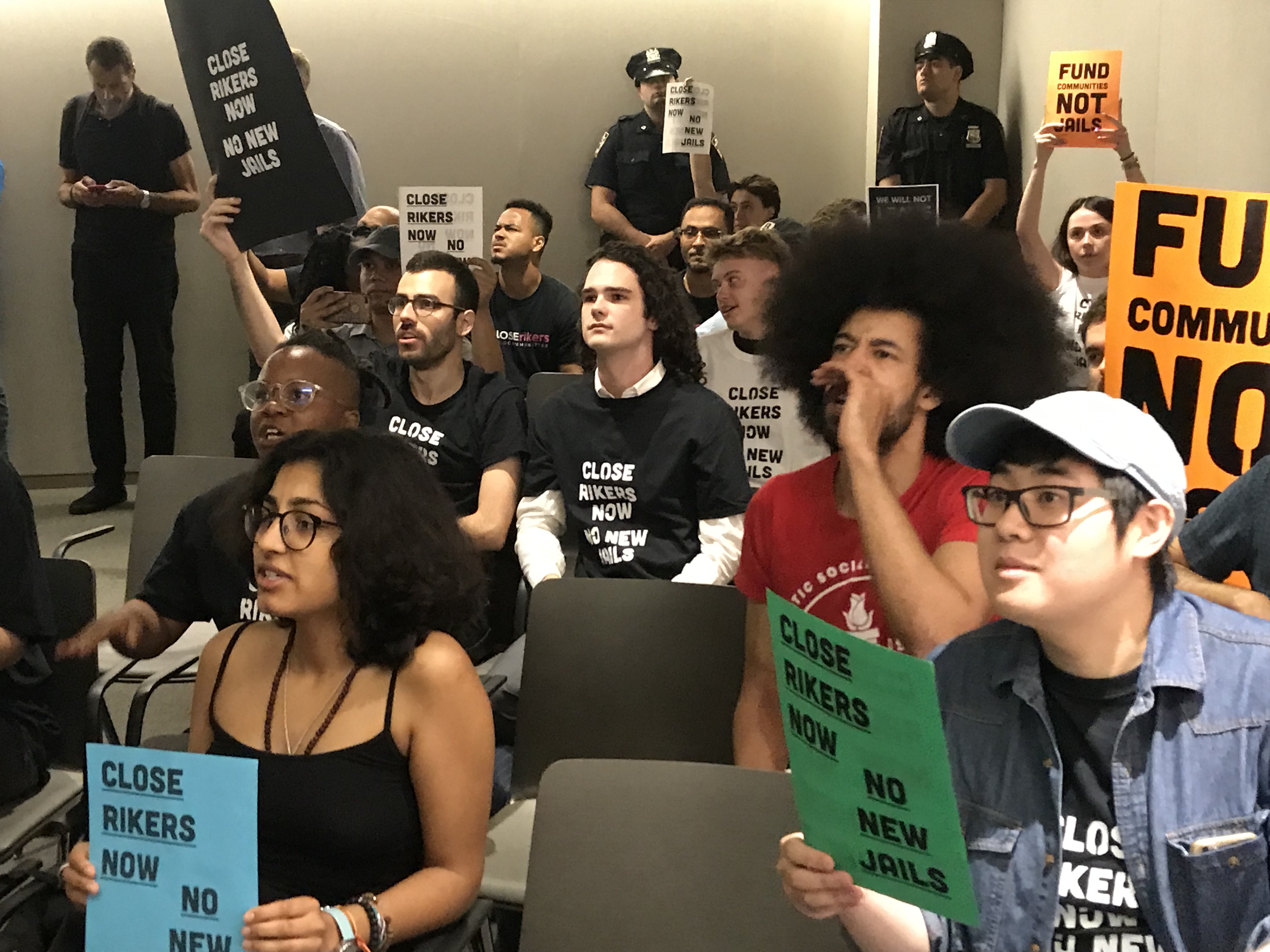
As the city fast tracks its plan for four borough-based jails to replace the dilapidated facilities on Rikers Island, the Bronx is definitely not in the house. The borough’s public officials continue to dig their heels in against a part of the plan that calls for building a 1,125 bed facility in Mott Haven.
At a Uniform Land Use Review Procedure (ULURP) meeting at its headquarters in downtown Manhattan on Tuesday, the City Planning Commission voted 9-3 in favor of Mayor Bill de Blasio’s plan to build smaller jails in the Bronx, Queens, Brooklyn and Manhattan, part of the city’s bid to continue shrinking the number of detainees through criminal justice reforms. As the Commissioners announced and explained their votes, some 50 raucous protesters from around the city drowned them out with shouts and chants of “No new jails” and “blood on your hands.”
One of the Commission’s three no votes was cast by the Commission’s Bronx representative Orlando Marín. In his testimony, Marín agreed with the findings of criminal justice reform advocates that “Rikers Island needs to be decommissioned and a more humane, decent and respectful correctional facility and/or system needs to be implemented,” but added that the Commission had heard compelling testimony from residents citywide that “the application and the citing of the facilities merit more time and scrutiny.”
Marín, a former chair of Community Board 2 in Hunts Point, agreed with Bronxites critical of the city’s call for a new facility along Concord Avenue, arguing that by siting it three miles from the criminal court on E. 161st Street the city is contradicting its own stated objective of placing jails and courts close together.
Representatives from the Mayor’s Office on Criminal Justice have emphasized that “jails should in fact be built in very close proximity to the municipal and/or court center within the municipality,” Marín said. Reformers’ “ideal scenario was one in which a jail would be immediately adjacent to, or joined by a physical connection to the court building where a direct exchange between inmate, courts and family could be had expeditiously and with human dignity,” leaving the current plan short of their stated goal, he added.
Bronx Borough President Ruben Diaz Jr. has called for the city to build instead on city- and state-owned property behind the courthouse, but planners have argued that that site is not big enough for the new facility.
Marín added that “this application falls short in several areas including the fact that it cannot factor in further jail reform changes being contemplated,” which will “begin being vetted in the first quarter of 2020. We cannot begin to fully comprehend the shape and built form that the proposed correctional facilities will take without first understanding and weighing all these and many more factors that will be the result of further prison reform.”
The other no votes were cast by Commissioners Alfred C. Cerullo of Staten Island and Raj Rampershad of Queens. Cerullo announced his thumbs-down with an unqualified “no,” while Rampershad cited public health and safety concerns as expressed by residents in prior community meetings, a lack of transparency on the part of city agencies and construction blueprints “too large in scale” that “should be modified.”
One Commissioner who voted yes, Allen P. Cappelli of Staten Island, nevertheless said that “the site in the Bronx troubles me,” because “it’s so far removed from downtown Bronx,” and “takes away from the planning of this to have people near the facility that they are going to be going in.” Still, Cappelli added, “the overwhelming factor for me is closing Rikers Island,” along with “bail reform, which is going to shrink the population of the people who are incarcerated.”
After the hearing ended, one Soundview resident who protested alongside others from the No New Jails movement, said he was angered but not surprised by the Commission’s decision.
“Eleven billion dollars is a hell of a lot of money,” said Shawn Hudson, 27, adding that “with that money you can fix NYCHA, you can fix the MTA.” Hudson complained that the City Council is “trying to pass it off as housing. It isn’t housing,” referring to part of the city’s plan to build housing on the Mott Haven site. Hudson said that many of his family members have been detained at Rikers over the years, helping form his opposing view.
But another Bronxite at the hearing, Harvey Murphy, differed vehemently, underscoring the rift between the two viewpoints over the construction of new jails to replace Rikers. Murphy, a resident of NYCHA’s Mott Haven Houses and former Rikers detainee who is a member of the Just Leadership initiative, which favors the new jail plans, fears that scrapping this plan means Rikers stays open.
“If we close (the new plan), then we lose,” he said, adding that he disagrees with the No New Jails movement’s message. “Where do you put someone who commits a heinous crime? What do you do when someone shoots up a school?”
Immediately following the Planning Commission’s yes vote, Bronx Borough President Ruben Diaz Jr. issued a press release urging the City Council to say no to a Mott Haven facility when it reviews the plan, in the next phase of ULURP.
“You, members of the City Council, have the ability to right this absurd wrong and force the city to select a better site for a new Bronx jail,” wrote Diaz Jr. in a statement. “Any failure to do otherwise will deleteriously alter the face of this borough for decades to come. We need your support.”

